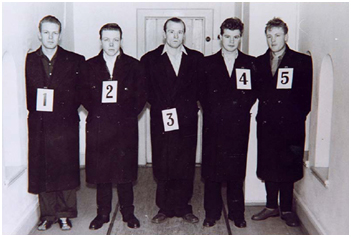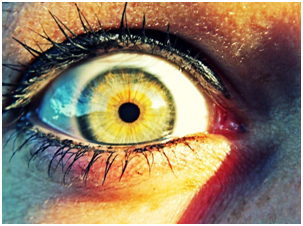Gemma Briggs and Louise Westmarland
International Centre for Comparative Criminological Research
The Open University
Most people probably think that they would be able to provide a good account of what happened if they witnessed a serious crime. Being able to identify the person who attacked them, for example, from a line up, might seem to be a fairly straightforward matter. However, a recent report from a committee tasked with assessing the factors affecting eyewitness testimony, recommended that all law enforcement agencies should ‘…provide their [personnel] with training on vision and memory and the variables that affect them’. Whilst it may appear to be common sense that research-based policing practice should be the norm, it is evident that this is not always the case. Why, then, has this recommendation been made and how could such training help to reduce erroneous convictions?
Fredrik Fasting Torgersen in the centre of a police lineup
Initiatives such as the Innocence Project highlight an alarmingly high number of cases where individuals have been convicted of crimes they did not commit on the basis of eyewitness identification. Whilst advances in forensic techniques, such as DNA testing, can help overturn some such miscarriages of justice, where forensic evidence isn’t available there still remains a tendency for jurors to assume that a confident eyewitness provides reliable evidence (Smith et al, 1989). So how should eyewitness evidence be regarded by jurors? Many researchers would claim that such evidence should be regarded with caution. This is because although police interviewing strategies, used in the UK at least, can help to focus a witness’s account of an event before their evidence is presented in court, the reliance on the witness’s memory remains. An eyewitness to a crime may feel very confident that their recollection of the event represents clearly what happened, regardless of the speed or traumatic nature of the event. They may also feel highly motivated to help the police secure a prosecution.
The desire of a witness to help the police and the confidence with which they present their account of events represent different problems for assessing eyewitness evidence. The police can control so called system variables – the methods and procedures employed to gather information from a witness, such as the cognitive interview and identification line up procedures – yet they can’t control factors such as the impact of stress, anxiety, distance from the perpetrator or the visual conditions at the time of witnessing the crime – the estimator variables (Wells, 1978). This type of ‘noise’ can affect how eyewitnesses process the crime as well as how they later recall the events. For example, an individual who witnesses a street robbery in a dark alley as they walk home from work may experience anxiety at being physically close to the attacker and fear for their own safety when the assailant sees them phoning the police. In these conditions, they may struggle to provide a clear description of the attacker or the sequence of events. Whilst poor lighting could explain the inability to describe the perpetrator’s face, the effect of fear, anxiety and distraction may be less obvious. Afterwards, the witness may feel able to provide an accurate description of the sequence of events and the physique of the attacker, which could potentially help police with their investigation, yet the emotion and distraction they experienced may well have altered their perception of the scene (Easterbrook, 1959). All of these factors, which are outside of the police’s control, are estimator variables.
A great deal of research has been conducted on memory for, and recall of, witnessed crimes, demonstrating the constructive nature of memory (Garry et al., 1996), the effect of leading questions (Kassin and Gudjonsson, 2004) and co-witness effects on accounts (Gabbert et al., 2003), as well as the suggestibility of vulnerable witnesses (Henry and Gudjonsson, 2007). This type of research has proven beneficial in controlling some of the system variables which could affect the evidence provided by eye witnesses. However, estimator variables are harder to pin down. Research on visual attention helps to highlight how what we perceive may differ from what is actually presented to us, and that simply looking at a scene doesn’t necessarily equate to seeing all aspects of that scene (Mack and Rock, 1997). The phenomena of change blindness (the inability to detect changes in a scene despite full attention being paid); and inattentional blindness (the inability to detect changes in a scene due to attention being allocated elsewhere, or being overloaded) can both demonstrate how a witness’s perception of an event may be affected, potentially leading to incorrect identifications.
Classic change blindness investigations (e.g. Simons and Levin, 1998) have shown that people can fail to notice a change in the identity of a person they are talking to if their contact with that person is briefly interrupted (e.g. a person ducks behind a counter and a different person then stands back up). If people fail to notice a change in the identity of someone they are talking to, how good are they at noticing changes from the perspective of an onlooker? Fitzgerald et al. (2014) showed participants a film of an innocent man entering a building. A theft then occurred, and a different (guilty) man left the building. 64% of participants who viewed the film failed to detect the change in identity. They were then shown a 6 person line up which was either target absent (contained the innocent man and 5 fillers) or target present (contained the guilty man and 5 fillers) and asked to rate their confidence in their identification. The 36% of participants who detected the change reported higher confidence in their identification accuracy than those who demonstrated change blindness, despite their identification accuracy not being significantly greater: those who demonstrated change blindness were more likely to misidentify an innocent filler in the line up (44%) than those who had detected the change (21%), but both groups showed similar rates of correct identifications in the target present line up
In a similar study, Smart et al. (2014) questioned whether expertise could affect change blindness susceptibility and identification accuracy. They showed groups of students and law enforcement officers a video of a staged traffic event, involving a speeding car being stopped by a police officer, during which the identity and clothing of the driver changed. Participants were asked whether they detected a change in identity, a change in clothes or both before viewing a line up containing six people. There were four different versions of the line up available: two where the target was absent (i.e. only innocent fillers were present), one containing driver 1 and another containing driver 2). Results revealed that students and law enforcement officers showed similar levels of change blindness (37.5% and 50.8%, respectively) but that students were significantly more likely to detect both the change in identity and the change in clothing than police officers (22.5% and 1.6% respectively). Further, only 3.3% of police officers detected the change in clothes, compared to 40% of students. Moreover, whilst those who detected the change in identity made more correct identifications than those who did not, police officers were less accurate on the identification task than students and demonstrated a greater likelihood of selecting an innocent person from a target absent line up. Smart et al. claim that their findings demonstrate that everyone is prone to change blindness and the ‘attentional set’ an individual applies to a scene may affect detection of different changes to that scene (e.g. officers were attending more to the driver’s behaviour than his clothing).
If the attentional set, goals and level of arousal of a viewer can affect what they see when witnessing a crime, it is easy to understand how two witnesses can provide different accounts of the same event. When witnessing a crime, an eyewitness isn’t just a passive surveyor of the events – they bring with them their own goals, past experiences and current concerns – all of which can affect what they look at, process, perceive and remember of the event. Given these factors, along with research into memory and identifications, it is crucially important that eyewitness accounts are treated with caution both by the police and jurors at trial. Educating and informing these groups of the potential pitfalls of eyewitness testimony at both the time of witnessing a crime and at police interview can only be a positive thing.



I am sure it was an Open University programme from the 80s – but could have been something else – where they had a group of newly-qualified police officers lined up in the car park behind the police station being spoken to by a senior officer, when a fire exit slams open, a man runs out, turns, fires a gun a couple of times back into the police station, then runs off round the corner.
The newly trained police were each asked for a statement describing the armed escapee (only an actor, of course) and between them they hadn’t a clue. They could not agree on what he did, what he looked like or what he was wearing.
The point being made was that if people freshly-trained in observation couldn’t be reliable witnesses, how much use are the rest of us?